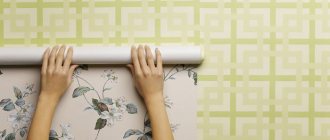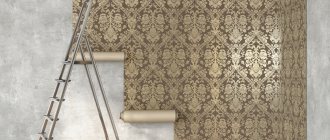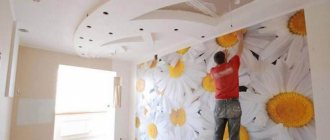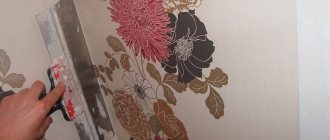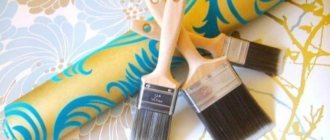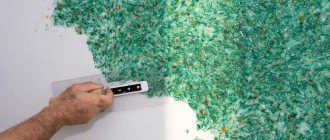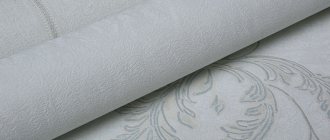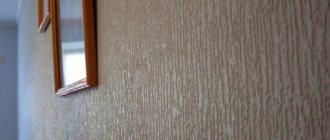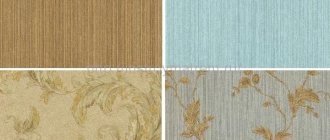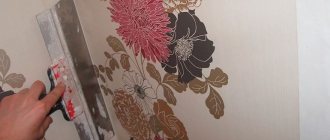Tired of old wallpaper? This means it’s time to update the appearance of the room and start some minor cosmetic repairs. The process of gluing wallpaper material itself is simple and does not take much time; the most tedious and time-consuming part of the work is often the removal of the old coating and preparation of the surface. Against this background, a natural question arises: is it possible to glue wallpaper onto old wallpaper, and if so, in what case?
To get a decent result, the old canvases are removed, the wall is leveled, degreased and primed. But to save time, effort and finances, the preparatory stage is sometimes omitted by gluing new wallpaper onto the previous ones.
When can you glue new wallpaper onto old ones?
In principle, it is possible to apply the material to an already pasted wall, but only if the following conditions are met:
- the existing finishing material, on top of which it is planned to attach a new one, must be paper;
- previously glued canvases must adhere firmly to the wall, not come off at the joints and have no defects;
- the surface on which new strips will be glued must be smooth, without a relief pattern;
- It is highly desirable that the old material be thin and single-layer.
The requirements for the already applied wallpaper coating and the rules for gluing photo wallpaper onto it are described in a separate article.
Is it possible to glue wallpaper over wallpaper?
Professionals believe that removing the old finish is a necessary step, and this is understandable. After all, previous wallpaper sheets themselves often do not stick well to the surface, and if you glue new ones to them, there is a possibility that they will fall off after a while. But at the same time, such a solution can significantly reduce the repair period and simplify the overall task.
Typically, the need to glue canvases to canvases arises for the following reasons:
- When the previous finishing material is held in place by reinforced glue and it is difficult to remove them;
- While removing the old finish, we encountered the problem that along with it the plaster layer was chipping off, which subsequently required an additional process of leveling the surface, which was not so easy to carry out;
- When the previous wallpaper was hung so long ago that it eventually “grew” to the wall.
In such cases, property owners may decide to install new wallpaper on top of the previous ones.
Professionals believe that removing the old finish is a necessary step.
Pros and cons of the solution
This technique can have both positive and negative sides. The advantages of carrying out such finishing are as follows:
- There is no need to waste effort and money to carry out dismantling work;
- Provided that the previous sheets are securely fastened, they keep the plaster intact;
- An acceptable base for gluing fresh wallpaper.
But why don’t experts recommend doing this? They note the following disadvantages:
- It will not be possible to eliminate defects on the surface;
- Poorly sealed areas may remain under the canvases;
- A new adhesive solution may contribute to the loss of adhesive properties of the previous one;
- Several layers of wallpaper may not adhere well to the surface;
- When choosing a thin new coating, the colors of the previous one will appear through it.
Provided that the previous sheets are securely fastened, they keep the plaster intact.
New wallpaper on vinyl flooring: is it possible or not?
You cannot attach new wallpaper directly to vinyl sheets. Regardless of the type of adhesive you choose, most likely it will simply not work, since the synthetic coating has water-repellent properties. This is especially true for washable wallpaper. Additionally, most vinyl materials have a textured pattern that will show through a fresh coat of finish.
However, there is still a chance to avoid complete elimination of such coverage. If, after removing the vinyl wallpaper, it was possible to remove the top polyvinyl chloride film, and the remaining paper or non-woven layer does not want to come off and adheres firmly to the wall, you can also glue a new sheet onto it.
USEFUL INFORMATION: Modern bedroom interior: we use two types of wallpaper
How to stick non-woven wallpaper on plaster?
Gluing non-woven wallpaper onto plaster is the most common method. It is only important before starting pasting to level the plaster with sandpaper (with an abrasive mesh on a block and treat the surface of the plaster with putty. If you use finishing plaster with a fine grain size, you can do without putty. But after treating the plaster with sandpaper, you need to sweep it with a broom and treat it with a primer (acrylic) .
It is advisable to use plaster as a base for gluing non-woven wallpaper to preserve the “breathable” properties of the wallpaper. In damp rooms, you can add PVA emulsion or liquid glass to the plaster. This will increase resistance to mold formation and wetness of external walls.
If the walls under the old wallpaper are already plastered, after removing the wallpaper, you should carefully inspect the plaster.
Carefully fill all cracks and defects, and treat the old plaster with a primer before gluing new wallpaper.
We assess the degree of risk
Before gluing wallpaper over the old coating, take into account the possible risks and disadvantages of this method:
- the quality of the adhesion of the canvases is reduced, as well as the service life of the new coating;
- under several layers of material the likelihood of mold development increases;
- there is a high risk of defects appearing on the surface, such as “bubbles” and partial peeling;
- the old coating, soaked after applying the adhesive, can stain the new canvas.
Considering these points, it is worth considering whether it makes sense to glue such expensive types of wallpaper as silk-screen printing or non-woven fabric onto an unprepared wall.
Let's summarize.
As you can see, there are quite a lot of disadvantages to this type of repair, such as wallpapering. For example, it very often happens that old wallpaper begins to peel off not at the moment when you were faced with a dilemma whether to remove it or not, but when a new coating has already been pasted on it and is pleasing to your eye. Or, for example, it may happen that one day a lot of bubbles form on your walls - signs of partial peeling of the wallpaper. And there are only 2 ways out of this situation: either start a new renovation, or put up with a sloppy wall.
Well, a new renovation, as you understand, means new expenses and extra wasted time. Therefore, when answering the question for yourself: is it possible to glue wallpaper onto wallpaper, it is better to think 10 times before making a final decision. But I personally would not recommend doing this kind of repair.
Is it possible to glue wallpaper onto wallpaper video
How to choose a material for gluing on old wallpaper
What wallpaper is suitable for gluing on top of the previous ones? When choosing, take into account the color intensity and brightness of the pattern on the old canvas. If the new gluing material is lighter than the previous one, the color of the bottom layer will show through. The following tips will help you choose:
- The material is selected darker than the coating that was glued earlier.
- Cloths that are too thin are not suitable; the old design will show through.
- Non-woven wallpaper cannot be used for the top layer: they often have a translucent structure.
- Treat vinyl material with caution as it is quite heavy and there is a risk of it falling off the wall along with the base layer.
- It is better to choose a canvas made of embossed paper, as in the following photo: on a smooth surface, possible flaws will be especially noticeable.
What are the advantages of non-woven fabric?
Non-woven base - namely, it gave the name to a whole group of wallpapers that differ in structure, density, relief and material composition; it is a semi-synthetic material based on natural cellulose. Unlike paper or fabric backing, non-woven fabric has a number of advantages:
- This is a very thin base.
- During the wetting process, the non-woven fabric does not stretch or deform.
- Non-woven fabric is vapor and air permeable.
- Old non-woven wallpaper can be easily removed.
- The service life of such wallpaper is 3-5 times longer than the service life of “traditional” wallpaper.
Why do non-woven wallpapers have so many advantages?
Non-woven fabric is a non-woven fabric consisting of cellulose fibers bonded together using adhesive components or by pressing. Due to its manufacturing technology, it contains much less chemicals than ordinary paper.
Any material composition can be applied to the surface of the non-woven base: paper, vinyl, fabric, bamboo or cork. Most non-woven wallpapers have a paper coating of varying degrees of relief, and are intended for painting with water-dispersion paints. After drying, the paint can be washed or repainted 2-3 times in a row. There are completely non-woven wallpapers - quite thick and heavy. They are easily recognized by the small shiny cellulose fibers on the outer surface of the fabric. They usually have a smooth surface and are used under paint.
Gluing rules
To successfully paste the selected wallpaper material onto already pasted walls, use the following recommendations:
- Be sure to make sure that the old canvases are held securely. You can lightly moisten the surface and then tear off the pieces of material extending from the base. The most common problem areas are the joints of the panels - inspect them carefully.
- Don't rush with gluing - start with one strip and wait until it dries. If everything is in order, then the test was successful and you can continue working.
- Limit the amount of adhesive - it should be sufficient, but not excessive. If you apply too much glue, the canvases will become soggy, heavy and may fall off after some time.
- Avoid air movement and drafts during work. The use of a convector, fan or air conditioner is prohibited; windows and doors must be closed.
USEFUL INFORMATION: Which wallpaper is best for a children's room?
Important! If a small number of bubbles appear on the surface after pasting, do not despair. You can try to smooth them out with a special spatula or even a simple iron. There is no need to be too zealous - after the surface has completely dried, they can smooth out on their own.
Advantages of non-woven wallpaper
Tools for wallpapering.
Today, the market for decorative finishing materials offers a lot of options for renovating an apartment or house. When choosing a material for gluing walls, you should take into account the existing disadvantages and positive aspects of the finishing material.
Non-woven wallpaper is made using a rather complex technological process based on compressed fabric and paper fibers. It is noteworthy that this material is highly strong, durable, resistant to fire, and also has soundproofing properties. The color palette and variety of textures and reliefs will allow you to bring any design solutions to life. All these advantages have become possible thanks to modern technologies, which have significantly increased the service life of finishing materials. Non-woven fabric does not emit harmful substances if it does not have vinyl components. In addition, such wallpaper can be painted with acrylic or dispersion paint if necessary. Often this opportunity is used by families with small children who love to paint the walls, puzzling their parents. High cost is the only significant drawback of non-woven wallpaper.
Article on the topic: Vampire anime cross stitch: embroidery according to patterns, watch cartoons and pictures, how to embroider simple characters in squares
What to do with liquid wallpaper
After we have dealt with the paper, vinyl and non-woven base, we will find out whether it is possible to glue new canvases onto liquid wallpaper. This is essentially not wallpaper in the standard sense; its properties are more reminiscent of decorative plaster; they are similar to paper webs due to the presence of cellulose. Since this material, applied in a layer of several millimeters, creates a fairly smooth surface, it will serve as a suitable base for gluing new trim. In addition, cellulose will absorb some of the water from the glue, which will also contribute to high-quality adhesion of the material.
In order for everything to work out as it should, consider a few important points:
- The layer of liquid wallpaper should not be damaged; any flaws must be corrected.
- If there are voids under certain areas of the liquid wallpaper, they need to be opened, coated with glue and the surface dried.
- A primer applied to the wall will significantly improve the adhesion of materials.
- The relief structure of liquid wallpaper can cause poor-quality results; the new finish will look good only on a smooth base coat.
- On a surface with a pattern, it is better to glue a dense material of a rich or dark color, but not a light one.
Thus, when figuring out whether it is possible to glue wallpaper to a previously pasted surface, you need to start from the type of material that is currently on the wall.
The following video will help you understand the nuances of gluing new wallpaper onto old ones.
How to properly glue wallpaper over old ones
When all the nuances are taken into account and suitable canvases are selected, it will be possible to begin the repair itself. To get the desired result, you will need to follow some operating rules:
- The base should adhere well to the surface, there should be no elements moving away from the wall, the surface should be flat;
- The base is paper material;
- Gluing is done in the area between the joints of the previous strips to secure the parts;
- Apply the adhesive solution in an even layer to avoid the appearance of bubbles and the removal of new sheets.
Apply the adhesive solution in an even layer.
Which glue to choose
To create strong adhesion to the surface, special attention must be paid to the choice of adhesive solution. The following requirements are taken into account:
- Weight and finishing material;
- Type of base;
- Room humidity level;
- Temperature readings in the room.
The construction market offers a large number of universal products for gluing wallpaper. They can be used for different bases, but are prepared in different ways; proportional rates will vary depending on the type of material that will be glued. If we are talking about gluing vinyl materials, then it is better to choose specialized products that can cope with their mass.
It is necessary to analyze the quality of the old coating. It is required to tap the wall with a small hammer; if many defects and places with defects are found, then you need to abandon the idea of skipping the stage of cleaning the surface from the previous finishing material.
If we are talking about gluing vinyl materials, then it is better to choose specialized products that can cope with their mass.
Preparatory work
It is possible to start gluing when all poorly secured elements have been strengthened. The cracks are closed with putty, the surface is leveled. If there are bubbles, you can use a hot iron; you should work through gauze.
To improve adhesion, the wall should be primed; the primer needs deep penetration. Apply glue only to a dry surface.
To improve adhesion, the wall should be primed.
Gluing technology
The adhesive solution is applied either only to the canvas, to the wall, or to both bases at once. Focus on the type of finish. The ceiling height is measured, strips are cut, and the pattern is joined on the floor.
The strip is glued so that the joints fall in the middle of the old strip. Gluing is done from top to bottom, the position of the canvas is gradually leveled, and the folds are leveled with a spatula or roller; it is necessary to remove air and excess glue, which is then wiped.
It is better to check the reaction of the surface; to do this, glue one strip and wait 24 hours. If the strip has not fallen, then you can proceed to pasting the entire room.
During operation, set temperatures in the range from 15 to 25 degrees. At the same time, drafts must not form in the room. It is possible to open windows and doors only after the adhesive solution has completely dried. The air conditioner should also not be turned on during this period.
Gluing is done from top to bottom, gradually leveling the position of the canvas.
General information
Is it allowed to glue new wallpaper onto old ones?
If we consider in detail whether it is possible to glue new wallpaper sheets onto old ones, then the answer is yes. This should be done taking into account the following restrictions:
If the old layer has an adhesion to the wall and excellent adhesion. It is worth paying attention to corner areas, seams, joints, where peeling and discrepancies are most often possible.- Wallpaper sheets should be glued to the old smooth finish, and in versions with patterns there will be a much smaller adhesion area, and therefore the quality of the pasting can be greatly affected, and the service life of this coating will become shorter.
- Any material should be glued to entire wall surfaces.
- It is best to choose wallpaper for a new layer in a dark shade with large patterns. Due to this technique, the previous wallpaper will not show through, and a large ornament can hide roughness and unevenness.
Please note that before gluing material over the old one, you should pay attention to the type of finish that is already in the wall surface. Depending on the variety, you should choose a new suitable coating, as well as a gluing technique.
Types of wallpaper
Paper
Is it possible to stick new wallpaper sheets on top of old paper wallpapers - definitely a positive answer. This is an ideal foundation that can last for many years. If paper wallpaper acts as a base, then it will make it possible to avoid bulges, irregularities and roughness. If you glue wallpaper made of paper as a second layer, then it will attach quickly, well and easily and will last for a long time.
Useful recommendation! In the case of paper options, you should choose a color and pattern darker than the old coating, because brighter colors tend to show through the half-transparent paper from below.
If paper wallpaper was glued to the surface of the wall, you can safely glue photo wallpaper on top of it. The main thing is that there is no roughness on their surface, because the thin material of the photo wallpaper makes any irregularities very noticeable. Before starting finishing work, you should definitely check the quality of adhesion of old paintings, make sure that there are no peelings or bubbles on their surface. If found, cleaning is required so that contact with moisture does not ruin the new repair.
Vinyl
With vinyl wallpaper on the wall, things are much more complicated. You cannot glue any coating on top of vinyl wallpaper, even similar ones. They have an oilcloth corrugated surface to which other types of materials will not adhere well. the new layer will only fall off if you glue them on top. The vinyl sheets themselves can be glued to old paper wallpaper, but then they will not last long because they are very heavy. There will be a high probability that they will simply tear off the paper base, which means it is important that the base has a strong adhesion to the walls. If you choose vinyl wallpaper for pasting, then to increase its service life, you need to take time to remove the old coating.
Non-woven
You can glue new wallpaper over old ones. In a large number of cases, many wallpapers are transparent, and therefore it will not be advisable to stick them on old ones, because they will show through. Experts will tell you with confidence that it is not recommended to glue non-woven fabrics onto paper coverings, because the material is synthetic in structure. Gluing on top of such wallpaper is also not important, because it is actually unrealistic. They usually have a corrugated surface and a very smooth film coating, and therefore it will not be possible to achieve a bonding effect.
Fiberglass
This popular option, like fiberglass, needs to be glued to a pre-prepared wall. Placing them on top of old paper is not advisable, because such a coating will need future plaster. The paper on the first layer is not able to withstand enormous weight. But if you work in the reverse order, then the fiberglass will be the base for gluing the new material, then you will need to achieve positive results. In operation, it will serve as an alternative to a reinforcing plaster layer, making it possible to level walls, insulate and strengthen them. In its pure form, fiberglass will not be able to serve as a replacement, but it will act as an excellent corrugated base for painting. As a rule, gluing glass wallpaper onto paper wallpaper does not make sense.
Liquid
Previously, this variety, namely liquid wallpaper, was not intended to be glued to any type of finish, including paper. The final layer of putty does not require treating the surface as thoroughly as in the case of glass wallpaper. This is the main advantage. It will be convenient to stick new wallpaper on liquid wallpaper, and it will also create a smooth wall. Thanks to the cellulose included in the composition, which is capable of absorbing the adhesive composition, excellent adhesion will be ensured.
Penoplex
This is a new generation product that will require gluing to perfectly prepared wall surfaces without remnants of old wallpaper or finishing. According to the installation technology, a film should be placed on the surface of the walls, which will help prevent the formation of fungus and helps retain moisture in the paper wallpaper finish. Wallpaper can be glued to penoplex, but preparatory work is mandatory. The structure of the material will be very fragile, for this reason reinforcement with a layer of putty is required.
Please note that finishing materials for wall insulation, which contain polystyrene foam, are best used outdoors, because they contain certain substances harmful to humans.
Cork
Finishing with cork will have many advantages. Among them:
- Ease of gluing.
- Availability of fire-resistant properties.
- Heat retention.
- Ecological cleanliness.
- Long service life.
- Great appearance.
Cork wallpaper is very convenient to stick to the surface of walls, because the outer layer resembles paper. Due to this, they will be securely attached to the walls, even if there is an old paper layer on them. It is impossible to glue other paper wallpapers on top of cork material, and most cork wallpapers are coated with wax or varnish, which will increase their service life.
For painting
Any other material will not work on painted wallpaper; the paper is not able to adhere to the paint and varnish material. Any type of finish that is intended to be painted must first be prepared and cleaned. Many layers of paint and varnish material will make the wallpaper heavier, and it will begin to lag behind the wall surface. For this reason, it is not worth gluing it to the painted layer or applying the composition to the second layer.
Other cases
When decorating a room, you should not forget even about the ceiling, the decoration of which is the most whimsical. The selected small-sized ornament will emphasize all the irregularities, curves, heavy wallpaper from the ceiling and ways to quickly lag behind. For this reason, the ceiling should be properly prepared for gluing, and it is advisable to completely get rid of the previous layers of paper so that the new ones stick well. You can glue photo wallpaper onto old ones, but you shouldn’t. In poor daylight or even in the evening, all joints and seams will be clearly visible.
Helpful advice! It is best to entrust work with photo wallpaper to craftsmen, since it will be difficult to glue this fancy material yourself.
There is such a type of wallpaper as washable. Nothing can be glued to them because they are covered with a protective film on top. It prevents the adhesive from penetrating into the inner layer, and the new wallpaper will not stick. The self-adhesive version is best glued to flat wall surfaces without any remnants of old paper. If you decide to make a new decoration in a room using old wallpaper, then the following problems may arise:
- The formation of joints and seams, bulges, and irregularities in photo wallpaper.
- Dark tones, large, bright and convex patterns begin to appear through the lighter colors of the new canvases.
- Poor adhesion and peeling due to existing defects on the old layers in the form of bubbles, peeling and others. Before starting work, you need to get rid of the remaining defects, and if there are a large number of them, you need to get rid of the old layer of finishing.
- Wallpaper peeling due to enormous weight.
Let's talk about the rules of work.
How to paint vinyl flooring
Methods for removing the old layer of vinyl wallpaper.
This is worth thinking about when new wallpaper has not yet been purchased. This method can save a lot of time and money. Painting is perfect if the old coating has retained its ideal appearance, there is no damage, but you are bored with the color or you just want to change something. Vinyl wallpapers come in regular and special types for painting. Both can be painted. The main thing is to choose the right type of paint.
It is possible to use several colors - this will significantly diversify the already familiar interior. There are several subtleties here. First, you need to carefully select the color so that when applied to colored vinyl, its distortion is minimal. It is advisable to check this on a small piece of coating remaining from the previous gluing. Secondly, it is better to consult directly at a hardware store about what type of paint to choose. As a rule, there are several options. The choice depends on the type of wallpaper and budget.
Leveling the surface
One of the mistakes is poor leveling of the wall before pasting. Unfortunately, using wallpaper you won’t be able to make curved walls straight. Depressions, protrusions and cracks become even more noticeable after pasting. Even small grains of sand and fallen pieces of putty appear on the surface and are noticeable.
Can a wall with old wallpaper be considered well-lined? It is probably possible if you first make sure that the wallpaper does not bubble over the entire surface, lies perfectly flat, and has no wrinkles, cracks or tears. But this should not be paper wallpaper with overlapping joints: the joints will also show through, and steps will appear under the new wallpaper, which will spoil the appearance. For the same reason, the old coating should not have any relief, volumetric decorative elements or other irregularities. The surface should be completely smooth and resemble paper in texture. This is rare with vinyl flooring.
Wallpaper glue
It is no secret that the quality of the work performed and the absence of consequences in the future depend on the correct choice of wallpaper glue. There are many types of wallpaper glue on the construction market. If you are going to glue non-woven wallpaper, then two types are suitable for this option: universal and special glue for non-woven wallpaper. In the first case, when mixing it, it is necessary to slightly violate the proportions indicated in the instructions and make the mass thicker by adding more adhesive powder due to the fact that non-woven wallpaper is heavier than the rest.
What to do if there is no way to remove old wallpaper
You can always remove the old covering from the wall. Experts offer many options that anyone can handle.
The easiest way is as follows: wet the wall with a damp cloth or using a spray; after 15–20 minutes, the wallpaper swells, the glue dissolves, bubbles appear under the paper, and they peel off from the walls. If the wallpaper does not get wet, then cuts are made using a knife to improve moisture penetration.
Before you begin this method, turn off the lights and outlets.
Even if this method did not help you, then stick it directly on the old wallpaper, but before that, read about the consequences that may arise with new wallpaper.
Stains on the wall after pasting
Another mistake is trying to cover colored spots on the wall with wallpaper. Even through dense layers, contrasting stains from plaster patches on large irregularities and streaks from technical fluids are visible. And if the stains are left by something coloring, then the substance is absorbed into the wallpaper over time and appears on the surface. To prevent this, professionals thoroughly wash the walls before gluing and apply a layer of light putty over the entire surface.
In the case of old wallpaper, it is difficult to predict how the dyes used in its production will behave, especially if the material has a bright and contrasting pattern. The situation is aggravated if you plan to glue light wallpaper onto an old coating of a darker shade. It’s definitely better to refuse this option.
This problem is less relevant for dark and dense new wallpaper, but you should always remember it.
What problems may arise with the new coating?
If we systematize the main ones, we get:
- It is not advisable to glue photo wallpaper onto wallpaper due to the appearance of joints, irregularities, and roughness.
- If there are dark or bright designs underneath, some of them may show through the lighter tones.
- You cannot apply new ones to old ones if there are defects in their layer - peeling, bubbles, etc. In such cases, it is necessary to remove the old wallpaper at least in such places. If there are many defects, it is better to remove everything.
- Even a thin paper layer will not withstand heavy coatings. If you apply many layers of paint or paste over the old ceiling, the repair will not last long.
Quick pasting can later lead to repeated work or poor quality repairs.
